There are lots of spring ephemerals I love, but, Virginia Bluebells might just be the prettiest of them all. As you're probably gathering, you can eat them too, and, they're delicious! They're one of the very first ephemerals to come up in the spring, and one of the most beautiful harbingers of the green landscape to come.
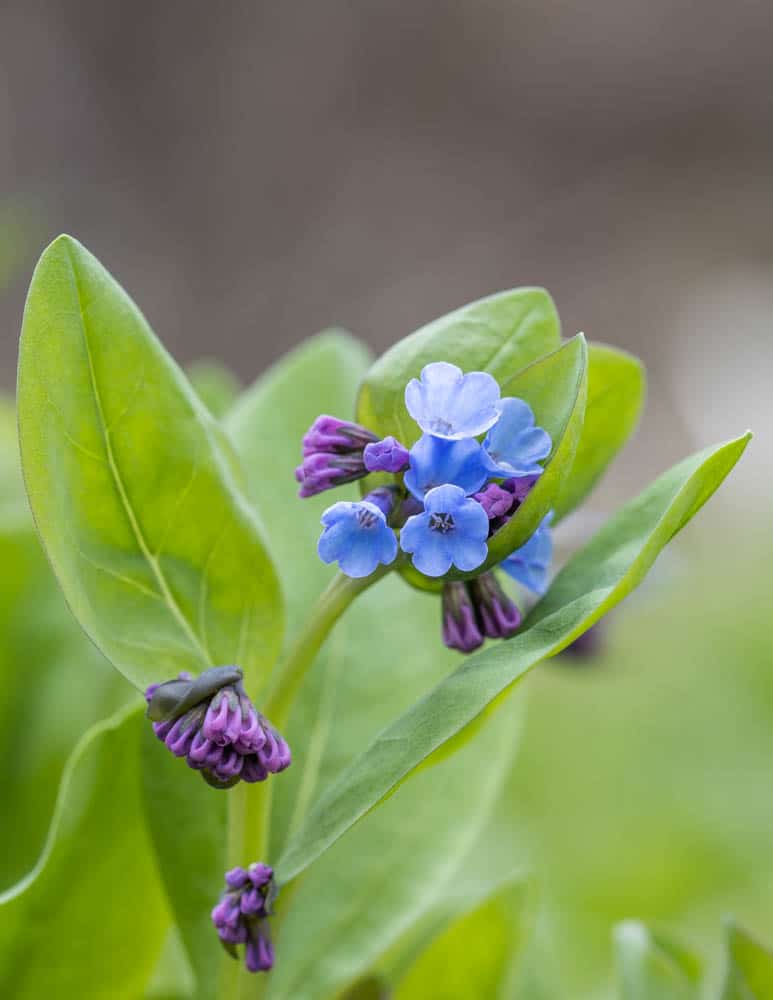
Varieties
There's at least two different types of these that I know of, but for the purposes of this post, I'm only referring to Mertensia virginica) since it's the only species I have eaten in quantity.
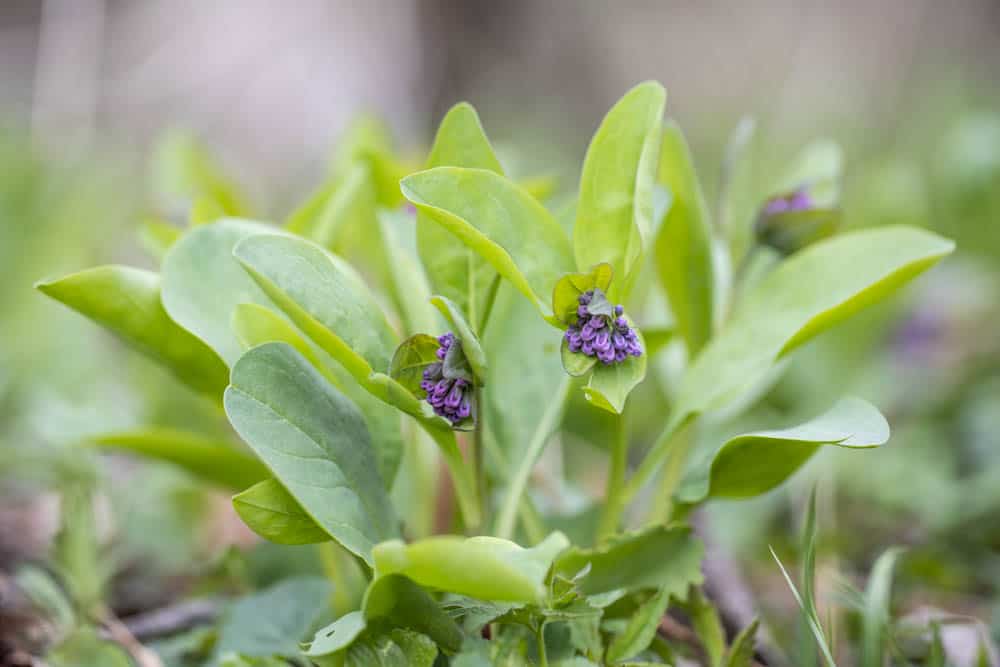
The other type I know that grows in Minnesota are Northern Bluebells (Mertensia peniculata) found in Northern Minnesota and the North Shore, I would assume they're edible as well, but I haven't tried them personally.
One extremely important thing to know is that in the U.K. (Hyacanthis non-scripta and others) are also known by the name bluebells and are poisonous to humans, horses and others.
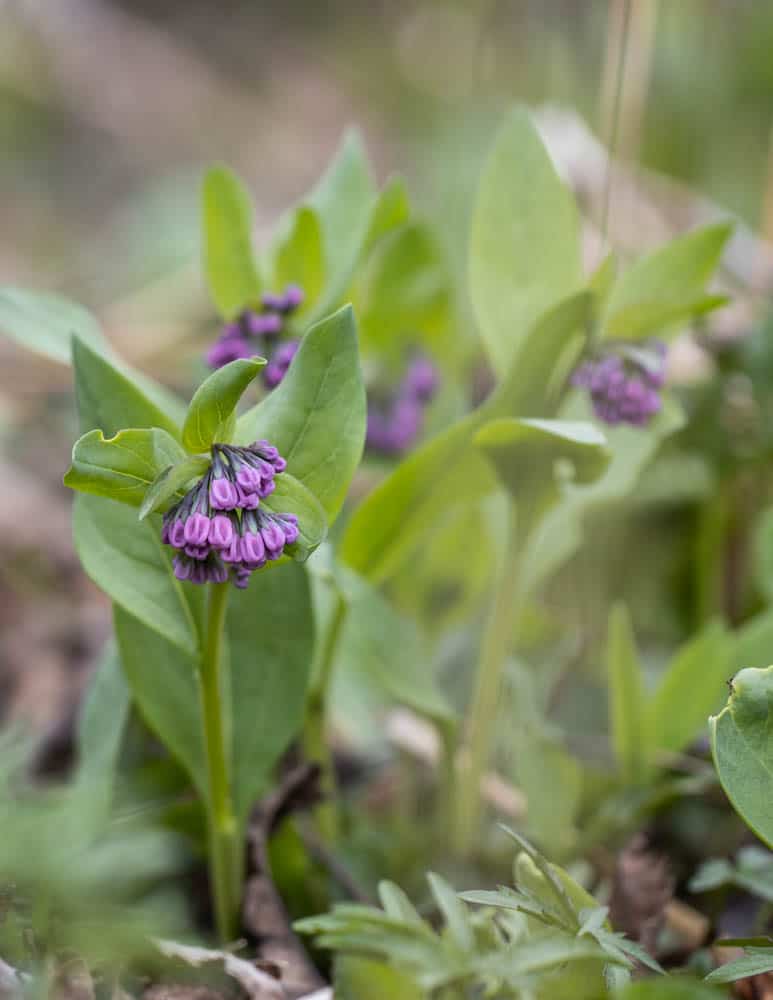
Habitat
I typically see Virginia Bluebells in areas with wet, moist soil and places around areas that may hold water, like floodplain forests or woods with large streams or rivers nearby, especially in Southeastern Minnesota. Many people also grow Virginia bluebells in gardens.

They're not usually something I have to hunt for if I'm in the right location-they're either not to be found, or easy to find, sometimes pretty thick, especially at the forest edge and places that aren't completely shaded.
While they're not aggressive like some plants that can be in the same habitat, they seem to be able to establish really healthy colonies and clusters in some places, similar to ramps that might be in the same terrain.

They have a wide range over the Eastern United States, but I've read in some places, like Michigan, they're not as common (they're on the endangered list there). So, before you go off to cut a bunch in your local woods, do some research on your terrain and assess their status.
An Edible Ornamental
The good part, and I mean the really good part about this plant being edible, is that, of the few people I've talked to about these, some of them didn't know that Virginia Bluebells even grew wild in Minnesota and Wisconsin because they only knew them as a garden plant!
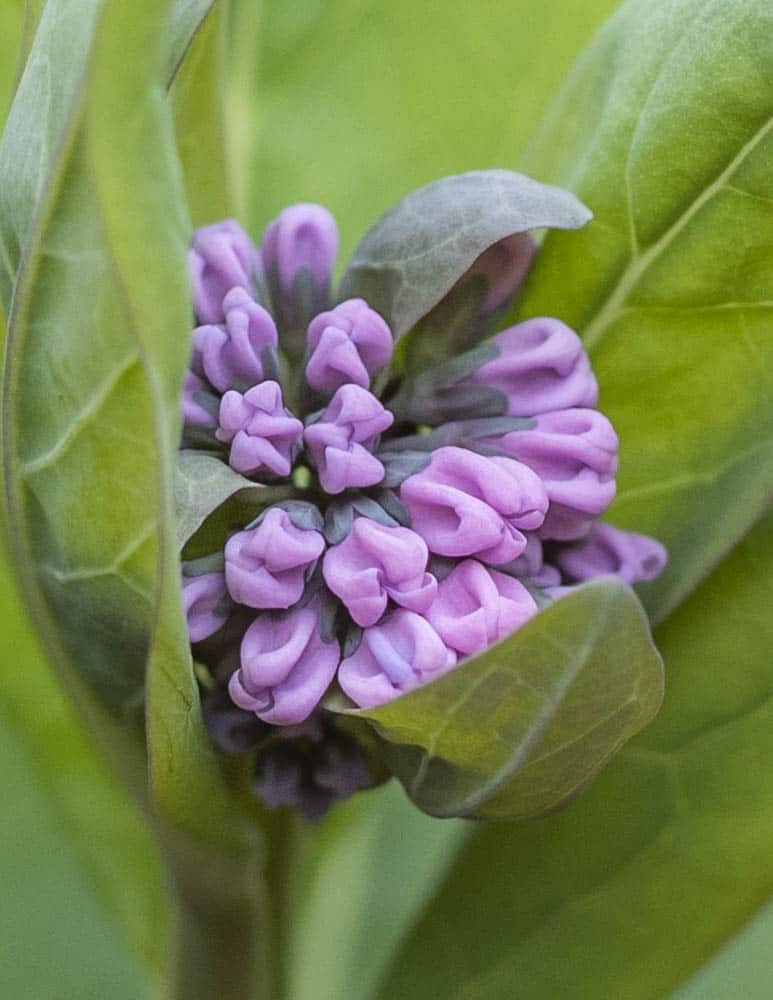
That means, if you want to taste them and don't feel like hunting them down, consider them as an edible addition to the garden or around the peripheries somewhere, especially if you have some spots with partial sun as they seem to prefer a little shade. Morning Sky Greenery has seeds for sale, and Prairie Moon Nursery does too, on occasion.
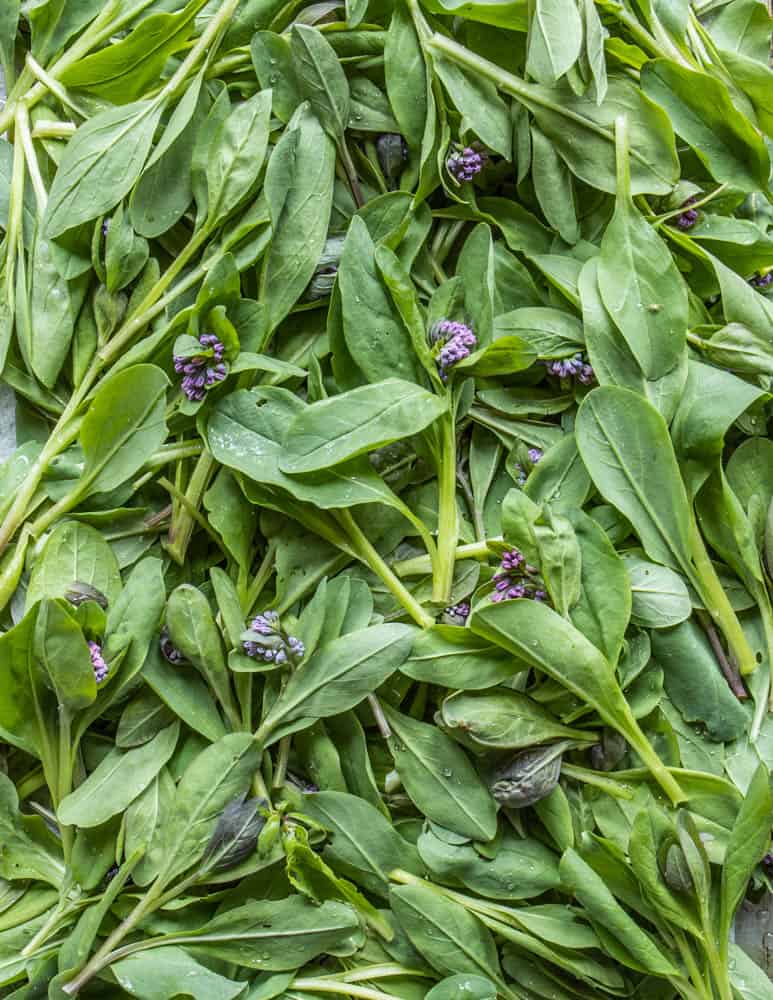
Harvesting
Like ramps, Virginia Bluebells like to grow in small colonies, so I've been modeling my harvesting techniques after how I harvest ramps, that is, I thin a couple juicy looking plants from the areas where I see the plants are growing the thickest, and after I'm done, I can't even tell I've been there.

The plants are delicate, so much so that I worried the first time I harvested them that they would wilt down to nothing sitting in a bag for a bit afterword, but, just like majority of other wild greens, once I got home and soaked them in a big bowl of cool water (the leaves naturally seem to repel water, which is nice for drying) they came right back to life, as if they'd just been plucked from the ground.
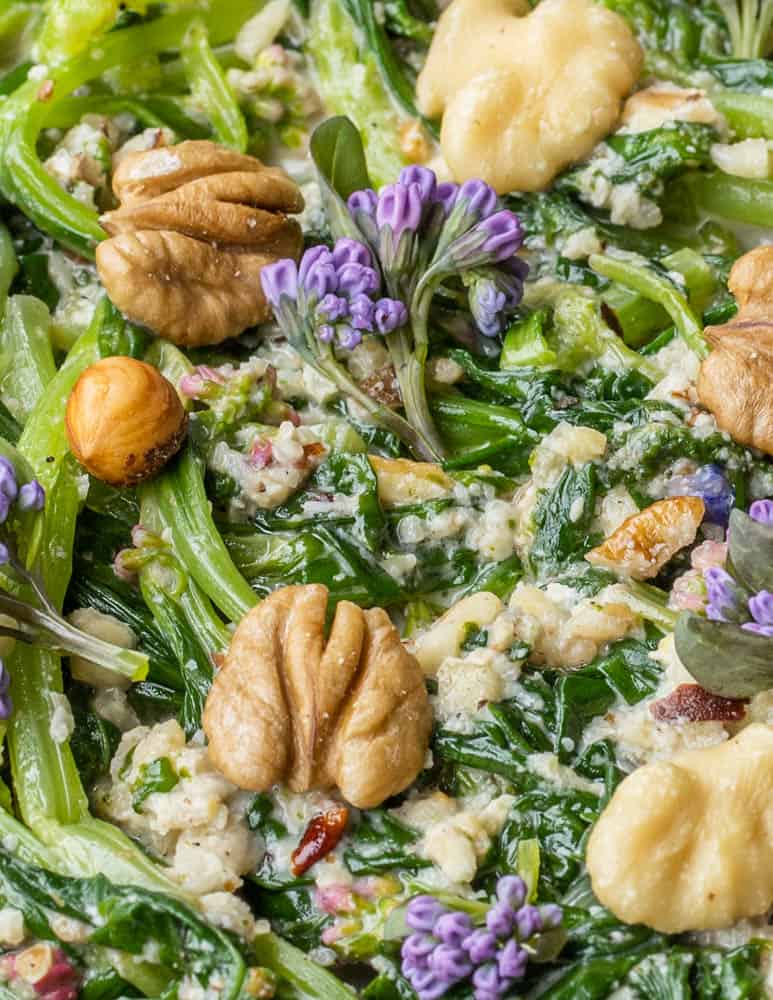
Cooking
The fun part. It's rare to find a plant almost as tasty as it is beautiful, but these are an example if there ever was one. Virginia Bluebells are in the Boraginaceae, along with the namesake plant (borage) which has a long history of consumption in Italy and Eastern Europe. Comfrey and Honeywort are also in the same family, although I don't make meals of comfrey sans a few flowers here and there.
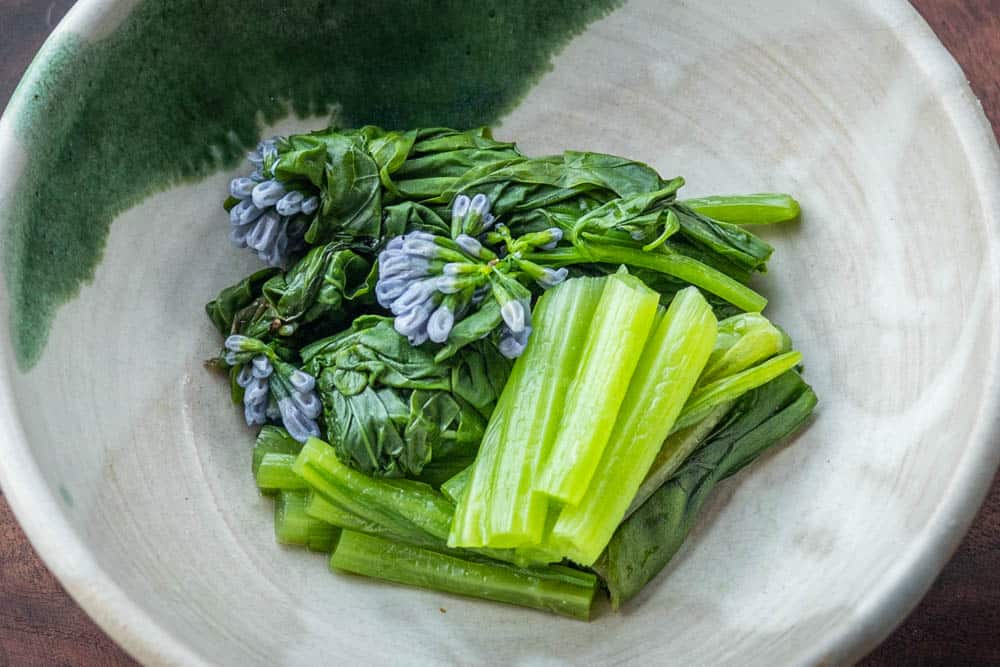
One taste of a raw leaf of Virginia Bluebells will show you the relation through flavor. Like borage, bluebell leaves and shoots have a unique, green flavor some might find strong raw. Some people might describe it as mushroomy, I'd probably call it aquatic as I don't like the term fishy. The aquatic quality is more concentrated in the leaves, the stems, which can comprise the majority of the plant, depending on when you harvest, are much sweeter and milder than the leaves.
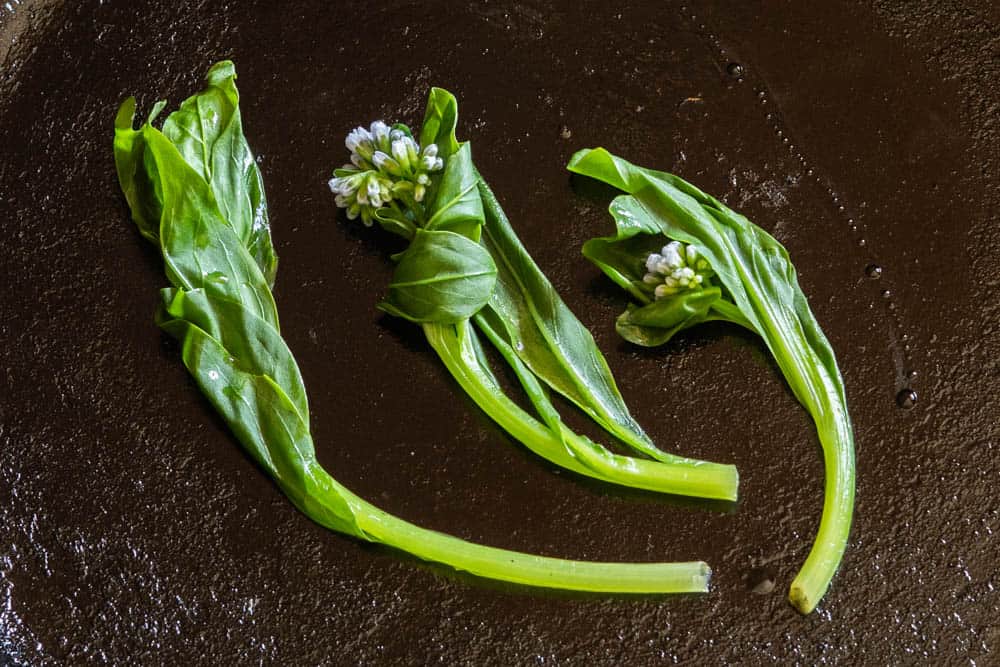
Don't worry though, the aquatic flavor isn't offensive, it's just interesting, and, after a very quick steam or literal dunk in boiling water, all I taste is delicious, tender green.
After cooking the plant will have little bitterness to it, but it's a good, gentle bitter—nothing comparable to dandelions, or the marginally edible (at best) garlic mustard or yellow rocket, both of the latter aren't worthy of being in the same basket as Virginia Bluebells, let alone the same plate.

Virginia bluebells, unlike a lot of other leafy greens, are almost more of a stem vegetable than leafy green. With their stem that can get quite long (up to a foot or more) during the season, they have a lot more texture than many of the plants available at the same time.
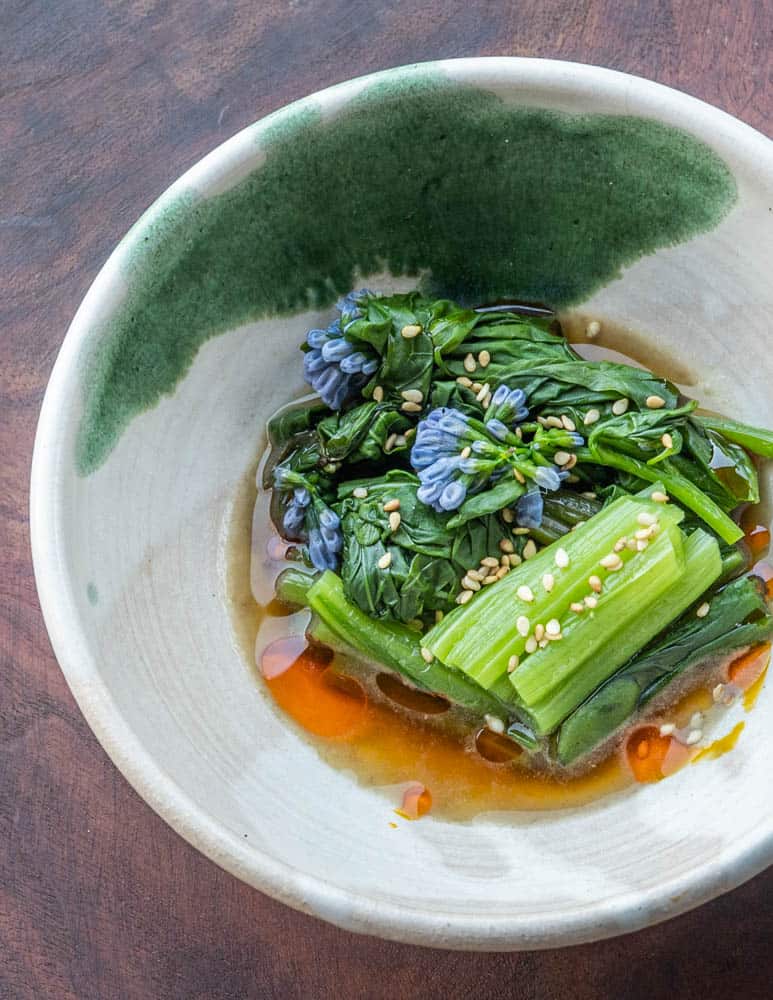
At the stage pictured here (about 4-8 inches) they're one of the most delicate shoots I've cooked, and need only a few moments (30-60 seconds of steaming) to reach a perfect, tender chew. Older shoots may take an extra 30 seconds, but not much longer. The recipe with a sauce made of nuts that follows here is similar to Italian and Slavic recipes for borage I've seen. If you get the chance, do yourself a favor try this beautiful plant for yourself.
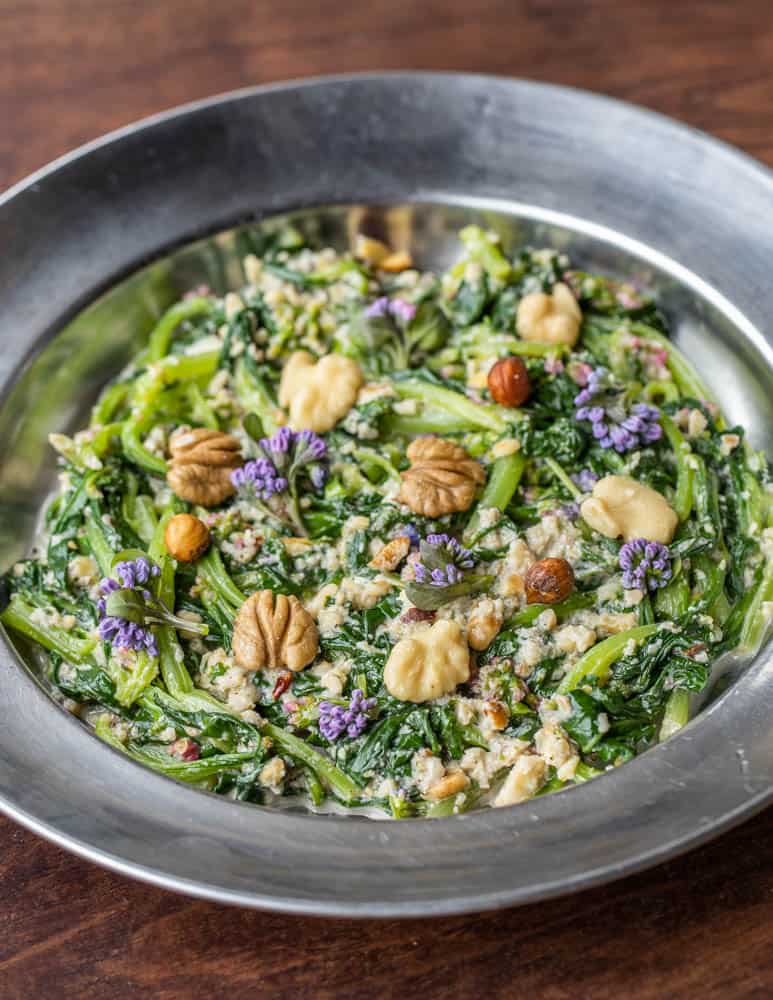
Virginia Bluebells or Borage Greens with Walnut Sauce
Ingredients
- 4 oz Virginia Bluebell shoots, 4-8 inches borage, or another green you like can be substituted.
- ¼ cup black walnuts or other nuts or seeds that are easily crushed
- 1.5 tablespoons extra virgin olive oil
- Pinch of kosher salt
- Fresh ground black pepper
- 1 medium clove of garlic
- 1 tablespoon fresh lemon juice and a scrape or two of zest
- 1 tablespoon sliced fresh mint leaves
Instructions
- Immerse the Virginia Bluebells in cold water and allow to soak for 5 minutes to clean them, then remove and gently spin dry. Reserve a few flower clusters for a garnish (optional).
- Toast the nuts lightly in a hot oven or pan until aromatic, then cool completely. Crush the garlic clove with a pinch of salt and pepper in a mortar and pestle and mash it up well, then add the nuts crush them, and gradually add the olive oil and lemon juice, mashing to a coarse paste.
- Season the paste with an extra pinch of salt to taste-it should be well seasoned. Reserve the nut paste.
- Meanwhile, prepare a steamer basket in a pot with 2 inches of boiling water, add the Virginia bluebells and cook until just hot and wilted (30-60 seconds was fine for me. Borage leaves will take longer to cook, they should be blanched in boiling salted water instead of being steamed.
- Taste a shoot here and there to make sure the texture is to your liking. If your shoots are longer than 5 inches, cut them into 1 inch segments before or after cooking.
- When you’re pleased with them, remove the shoots and leaves with tongs to a bowl, allowing some water to drip off in the process.
- Add the walnut paste and mint to the greens and mix thoroughly but gently. From here the greens can be put in a covered container and held for serving later, but I think they’re probably best, still a bit warm, straight from the pot.
- Before serving, double check the seasoning quick and adjust as needed for oil, salt, pepper, and lemon until it tastes good to you. Serve cool or at room temperature.
Notes
- Use sesame seeds or sunflower seeds instead of walnuts.
- Use your favorite vinegar instead of lemon juice
- Use spinach, chard, or other greens you like.
Nutrition


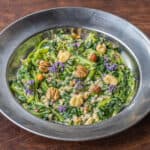
Erik
Do you have any links to a thorough chemical analysis of this plant (or of Mertensia maritima as a better known, related proxy)? The Boraginaceae (which in latest taxonomy seems to have been split up, but remains as the Boraginales) scares me because so many of them have pyrrolizidine alkaloids, most of which have been identified as rather insidious, irreversible, chronic liver toxins.
Alan Bergo
Refer to Sam Thayers monumental field guide to edible plants of Eastern North America. There’s likely many references we don’t have on this and M. maritima as they’re used by indigenous cultures with oral traditions. It is definitely not like comfrey root, or something like that. I’ve been eating it for years now, and I have numerous peers that eat M. virginica now too. As far as a chem analysis specifically, no. Someone should do a chem analysis of a Big Mac.
Paula C
Is there anything known about the edibility of the tuber?
Alan Bergo
I wouldn't bother as I haven't seen anyone eat them and the greens are so good. I can't speak to it personally.
Alfred Menendez
I live in Idaho and I've tried the mountain bluebells we have out west here, they grow quite large (2+ feet tall!). Although the younger (4-8 inches) plants are best, and have that really nice aquatic flavor.
I was wondering if you think that aquatic flavor would intensify by deep frying (similar to what can be done with sage, basil, etc) or if the cooking process destroys those flavors, as I've kinda noticed when I've sautéed them.
Alan Bergo
Yeah I wouldn’t fry these, much better to just saute or steam and eat fresh.
Rustom
Thanks for the comprehensive article on bluebells! A note about garlic mustard: keep nibbling on it when you see it.
Most of the patches are not very good; quite bitter. However, some patches have low to no bitterness, and a strong garlic flavor. I have made superb pesto out of the latter; it provides both greens and garlic flavor in one ingredient.
I don't know if the variation in flavor is due to genetics or how much sun they get. I don't think it's lifecycle, as I've tried them at all stages.
Alan Bergo
Thanks Rustom.
Keith
I don't know if you remember me, but I've been working on elderberry/elderflower vinegars and balsamics. I got my first batch approved, brewed and bottled. I'd love to send a sample bottle of each and get your opinion. This has been a 3 year obsession. I'm still working on the website but http://www.foragedbounty.com. Please let me know where to send some samples. I like them, but I'm not a chef and cooking your recipes only reinforces that.
I heard you on the Wildfed podcast and was shocked that bluebells are edible! I've always heard they were mildly poisonous. I tried a flower once expecting to taste something like a violet and got the mild oyster taste. I immediately spit it out thinking POISON! I can't wait to try them as a green again next year.
Alan Bergo
Keith, it gets confusing because there's a bluebell in Europe that definitely is poisonous. I need to add a mention of it in this, thanks for the reminder.
Veri
What are your sources for Mertensia virginica's edibility (besides having eaten & served it - this is good data, but not cultural or scientific data, and can't necessarily address long-term risks)? Thanks so much! I tried a stalk a couple weeks ago and it was indeed delectable.
Kelly Chadwick
Up here in Washington we have Northern Bluebells. I have always used the term fishy and it's pretty strong with this species. However, excited to try some and think Aquatic. Thanks for article!
Alan Bergo
Kelly, re: fishy yes. The term is just a pet peeve of mine, and the power it conveys to people turns them off before giving it a chance. Common nettles have a similar flavor, sometimes I call it saline. As M. maritima is also called oyster plant the flavor has to be similar through the species. I found them much more mild after cooking.
Gina
I’m intrigued by the edibility of wildflowers. I have noticed that some sites state that Virginia Bluebells are toxic but other sites say it’s edible. Are the flowers edible raw too? You mention tasting the leaves in this article but you don’t mention the flowers. I’ve read that the native Americans have eaten the plant but it didn’t say if it was cooked first or eaten raw. Your help in clearing this up would be appreciated.
Alan Bergo
Gina, as you can see in my images of the cooked dishes here the flowers are edible, and you'll see they're mentioned in the recipe. Sorry if that wasn't clear.
Gina
The edibilty of the flowers raw was my question.
Alan Bergo
Yes they're edible raw. I've seen mentions of M. maritima eaten raw by Eskimos too. I'll have to adjust the post to reflect that more specifically.
Gina
Thank you so much for your help. I greatly appreciate it. I enjoy learning from your site!
Etta
I was thinking of planting bluebells for their color but try to plant things safe to family & pets as well as local wildlife/stray animals. Like commenter Gina, I have read several sites stating bluebells/Virginia bluebells are toxic (to horses, cows, dogs, cats & humans and deer, rabbits & squirrels avoid them for that reason. Additionally, some sites say highly toxic, vomiting & diarrhea if eaten, death if eaten in large quantities, watch your pets & children, can cause skin irritation from just touching the plant and sap is worse. One site is European so I wondered if there's a different species of bluebell there, but the others are US based.)
Then your site highly contradicts them with beautiful, delicious looking recipes! You seem to have eaten them many times & in different ways. How did you decide to try them the first time? Have you or others you know had any reactions after eating? Do you think some negative reactions could be an individual thing? I've tried dandelion, for example, after seeing a recipe for a salad the author loved and my thought was no, won't eat that again!
Alan Bergo
Hi Etta. Thanks for reminding me of this as I was meaning to update it. This is a great example of why Latin names are important. As I mention in the post, the bluebells pictured I've cooked and eaten, along with a fair number of other people in the foraging community now, are Mertensia virginica. The poisonous bluebells from the U.K. are a completely different plant (Hyacinthus non-scripta and others). One plant is edible, the other is poisonous. I learned about them from my friend Sam Thayer, a well-respected foraging author and friend of mine who is the most skilled forager I've ever met.
David Cole
Thanks for the inspiration and recipe!
Had them tonight with your recommended nut,garlic, olive oil dressing.
I did add fresh Cerioprus squamosus strips and some Coprinellus micaceus caps with a final splash of truffle butter!
Delicious and delightful! Especially with the blossoms as accents!
So many thanks again for your knowledge and inspiration!!!
Alan Bergo
Thanks David.
Tammie
lovely to read about this beautiful plant. I am not sure that we have virginia bluebells here in Montana, they look very similar. I have seen them in pure white. Your paste sounds like it would be good on all sorts of things.
Thank you for sharing.
Marybeth
I stepped on a mertensia shoot in my garden today and almost put it in my mouth to take a taste, as it felt, somehow, that I could eat it. Stopped myself, of course, because I didn't KNOW it would be edible, and thought that I should check it out, as I have a rampant population this year, along with ostrich fern and virginia waterleaf. So I'm checking my email just now, and voila, your post!
Love your website, you have given me lots of inspiration over the years! Thank you!
Alan Bergo
Thanks Marybeth.
Judy Krohn
I'm THRILLED to learn this information! I have a large patch of these in my front yard that I've dug and shared with friends over the years. On my dinner menu this evening, since they are at just the right stage.
I appreciate your comments about the edibility of garlic mustard, as well. I haven't found a good way to eat this, although mixing with mashed potatoes (sort of like colcannon) is about the best I've tried.
Alan Bergo
thanks Judy, you'll love them.
Gina
This post came at an opportune time, as I need to thin the Mertensia in my yard so they don't completely shade out the later-emerging perennials under them. I'm glad to have this recipe to try out instead of composting them!
Alan Bergo
Enjoy thinning!
Dave
I think it’s been pretty well covered but if you need another source, the USDA has the plants listed as toxicity - none.
https://plants.usda.gov/home/plantProfile?symbol=MEVI3
Excited to plant these alongside Wood Nettle and Fragaria Virginiana.
Alan Bergo
Hey thanks that's great. The ethnobotanical evidence of M. maritima being consumed really sealed it for me as they're so closely related, well that and I trust Sam Thayer with my life. I think the big confusion comes from the poisonous European plant with the same common name.
Sylvie
I have always wondered about the edibility of Virginia bluebells, especially as a close cousin Mertensia maritima (native of Northern Europe) is edible and nicknamed Oyster plant (for it's supposed oyster taste - a flavor from teh see, for sure). Although just because one species is edible does not mean that another of the same genus is (witness the Amanita genus!). But still, I don't know that I can bear to eat y bluebells
Alan Bergo
I'm well aware that one plant in a genus doesn't mean they're all edible, which is why I mention I only eat comfrey flowers in small amounts.
Sylvie
Alan, I did not mean to imply you did not know that! I was trying to convey my hesitation about the edibility of Virginia Bluebells before I read your post. After all, I come here to learn 🙂 It is indeed an obscure (but oh-so-showy) edible. I still don't think that I can bear to eat mine - not because I question the edibility, but because they are so poignantly beautiful, and for such a short time as well. Maybe when my patch is a lot bigger, I'll carefully will harvest a few stems. Also, it's interesting that they are blooming for you now, at the same time as for us in Virginia
Nina
Wow! This was a new green for me!! I can't imagine eating my beautiful Virginia Bluebells! Nonetheless, I'll have to give it a go. I plant a lot of borage in my herb garden each year and may try this recipe with them too. Thanks!!
Alan Bergo
Nina, it's a great one, you'll love them.